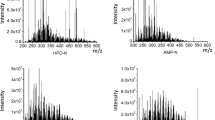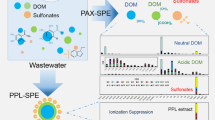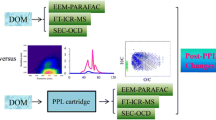Abstract
Electrospray ionization (ESI) coupled with Fourier transform ion cyclotron resonance mass spectrometry (FT-ICR MS) has been widely used for the characterization of dissolved organic matter (DOM) extracted by solid-phase extraction (SPE) from various environmental waters. It is known that common SPE generally has a relatively low recovery and the non-polar and weakly polar components are less likely to be ionized due to ionization discrimination. However, the molecular selectivity during SPE is not clear so far. In this study, the Suwannee River natural organic matter (SRNOM) was fractionated by multi-step SPE with different solvents and the fractions were characterized by negative ESI FT-ICR MS and trapped ion mobility spectrometry-mass spectrometry (IMS-MS). The sequential solvent elution increased the extraction recovery of DOM in water by SPE and enabled the characterization of a weakly polar component, which cannot be detected in common SPE separation. The weakly polar component accounts for 5.7% in TOC for the SRNOM, which has complex but different molecular composition with methanol- and/or water-eluted fractions. Lipid-like compounds were enriched in this fraction. Compared with the polar molecules directly eluted by one-step SPE from the SRNOM, the weakly polar fractions exhibit larger molecular size. The results are helpful for understanding of the molecular composition of SRNOM, as well as other environmental waters. In addition, the study demonstrates that the combination of FT-ICR MS and IMS-MS has potential to characterize the chemical composition of a complex mixture, like DOM, to a new depth.

Graphical abstract









Similar content being viewed by others
References
Leenheer JA, Nanny MA, McIntyre C. Terpenoids as major precursors of dissolved organic matter in landfill leachates, surface water, and groundwater. Environ Sci Technol. 2003;37(11):2323–31. https://doi.org/10.1021/es0264089.
Kristensen E, Bouillon S, Dittmar T, Marchand C. Organic carbon dynamics in mangrove ecosystems: a review. Aquat Bot. 2008;89(2):201–19. https://doi.org/10.1016/j.aquabot.2007.12.005.
Ward ND, Keil RG, Medeiros PM, Brito DC, Cunha AC, Dittmar T, et al. Degradation of terrestrially derived macromolecules in the Amazon River. Nat Geosci. 2013;6(7):530–3. https://doi.org/10.1038/ngeo1817.
Fievre A, Solouki T, Marshall AG, Cooper WT. High-resolution Fourier transform ion cyclotron resonance mass spectrometry of humic and fulvic acids by laser desorption/ionization and electrospray ionization. Energy Fuel. 1997;11(3):554–60. https://doi.org/10.1021/ef970005q.
Kujawinski EB, Del Vecchio R, Blough NV, Klein GC, Marshall AG. Probing molecular-level transformations of dissolved organic matter: insights on photochemical degradation and protozoan modification of DOM from electrospray ionization Fourier transform ion cyclotron resonance mass spectrometry. Mar Chem. 2004;92(1–4):23–37. https://doi.org/10.1016/j.marchem.2004.06.038.
Sleighter RL, Mckee GA, Liu Z, Hatcher PG. Naturally present fatty acids as internal calibrants for Fourier transform mass spectra of dissolved organic matter. Limnol Oceanogr Methods. 2008;6(2):246–53. https://doi.org/10.4319/lom.2008.6.246.
Herzsprung P, Hertkorn N, von Tuempling W, Harir M, Friese K, Schmitt-Kopplin P. Molecular formula assignment for dissolved organic matter (DOM) using high-field FT-ICR-MS: chemical perspective and validation of sulphur-rich organic components (CHOS) in pit lake samples. Anal Bioanal Chem. 2016;408(10):2461–9. https://doi.org/10.1007/s00216-016-9341-2.
Koch BP, Witt MR, Engbrodt R, Dittmar T, Kattner G. Molecular formulae of marine and terrigenous dissolved organic matter detected by electrospray ionization Fourier transform ion cyclotron resonance mass spectrometry. Geochim Cosmochim Acta. 2005;69(13):3299–308. https://doi.org/10.1016/j.gca.2005.02.027.
Gonsior M, Peake BM, Cooper WT, Podgorski D, D'Andrilli J, Cooper WJ. Photochemically induced changes in dissolved organic matter identified by ultrahigh resolution Fourier transform ion cyclotron resonance mass spectrometry. Environ Sci Technol. 2009;43(3):698–703. https://doi.org/10.1021/es8022804.
Mangal V, Stock NL, Gueguen C. Molecular characterization of phytoplankton dissolved organic matter (DOM) and sulfur components using high resolution Orbitrap mass spectrometry. Anal Bioanal Chem. 2016;408(7):1891–900. https://doi.org/10.1007/s00216-015-9295-9.
Nebbioso A, Piccolo A. Molecular characterization of dissolved organic matter (DOM): a critical review. Anal Bioanal Chem. 2013;405(1):109–24. https://doi.org/10.1007/s00216-012-6363-2.
He C, Jiang B, Shi Q, Hsu CS. Comment on “laser desorption/ionization coupled to FTICR mass spectrometry for studies of natural organic matter”. Anal Chem. 2018;90(9):5965–7. https://doi.org/10.1021/acs.analchem.8b00332.
Ohno T, Sleighter RL, Hatcher PG. Comparative study of organic matter chemical characterization using negative and positive mode electrospray ionization ultrahigh-resolution mass spectrometry. Anal Bioanal Chem. 2016;408(10):2497–504. https://doi.org/10.1007/s00216-016-9346-x.
Dittmar T, Koch B, Hertkorn N, Kattner G. A simple and efficient method for the solid-phase extraction of dissolved organic matter (SPE-DOM) from seawater. Limnol Oceanogr Methods. 2008;6(6):230–5.
Chen M, Kim S, Park J-E, Kim HS, Hur J. Effects of dissolved organic matter (DOM) sources and nature of solid extraction sorbent on recoverable DOM composition: implication into potential lability of different compound groups. Anal Bioanal Chem. 2016;408(17):4809–19. https://doi.org/10.1007/s00216-016-9569-x.
Chen M, Kim S, Park J-E, Jung H-J, Hur J. Structural and compositional changes of dissolved organic matter upon solid-phase extraction tracked by multiple analytical tools. Anal Bioanal Chem. 2016;408(23):6249–58. https://doi.org/10.1007/s00216-016-9728-0.
Lewis AT, Tekavec TN, Jarvis JM, Juyal P, McKenna AM, Yen AT, et al. Evaluation of the extraction method and characterization of water-soluble organics from produced water by Fourier transform ion cyclotron resonance mass spectrometry. Energy Fuel. 2013;27(4):1846–55. https://doi.org/10.1021/ef3018805.
Ridgeway ME, Lubeck M, Jordens J, Mann M, Park MA. Trapped ion mobility spectrometry: a short review. Int J Mass Spectrom. 2018;425:22–35.
Cumeras R, Figueras E, Davis CE, Baumbach JI, Gràcia I. Review on ion mobility spectrometry. Part 1: current instrumentation. Analyst. 2015;140(5):1376. https://doi.org/10.1039/c4an01100g.
May JC, Mclean JA. Ion mobility-mass spectrometry: time-dispersive instrumentation. Anal Chem. 2015;87(3):1422–36. https://doi.org/10.1021/ac504720m.
Huang R, McPhedran KN, Gamal El-Din M. Ultra performance liquid chromatography ion mobility time-of-flight mass spectrometry characterization of naphthenic acids species from oil sands process-affected water. Environ Sci Technol. 2015;49(19):11737–45. https://doi.org/10.1021/acs.est.5b03178.
Noestheden MR, Headley JV, Peru KM, Barrow MP, Burton LL, Sakuma T, et al. Rapid characterization of naphthenic acids using differential mobility spectrometry and mass spectrometry. Environ Sci Technol. 2014;48(17):10264–72. https://doi.org/10.1021/es501821h.
Lalli PM, Jarvis JM, Marshall AG, Rodgers RP. Functional isomers in petroleum emulsion interfacial material revealed by ion mobility mass spectrometry and collision-induced dissociation. Energy Fuel. 2017;31(1):311–8. https://doi.org/10.1021/acs.energyfuels.6b02411.
Lalli PM, Corilo YE, Rowland SM, Marshall AG, Rodgers RP. Isomeric separation and structural characterization of acids in petroleum by ion mobility mass spectrometry. Energy Fuel. 2015;29(6):150516102226003.
Arif A, Yunju C, Kevin G, Eleanor R, Jong Wha L, Kim HI, et al. Elucidating molecular structures of nonalkylated and short-chain alkyl (n < 5, (CH?)n) aromatic compounds in crude oils by a combination of ion mobility and ultrahigh-resolution mass spectrometries and theoretical collisional cross-section calculations. Anal Chem. 2014;86(7):3300.
Fernandez-Lima FA, Christopher B, Mckenna AM, Rodgers RP, Marshall AG, Russell DH. Petroleum crude oil characterization by IMS-MS and FTICR MS. Anal Chem. 2009;81(24):9941–7.
Becker C, Qian K, Russell DH. Molecular weight distributions of asphaltenes and deasphaltened oils studied by laser desorption ionization and ion mobility mass spectrometry. Anal Chem. 2008;80(22):8592–7.
Benigni P, Fernandez-Lima F. Oversampling selective accumulation trapped ion mobility spectrometry coupled to FT-ICR MS: fundamentals and applications. Anal Chem. 2016;88(14):acs.analchem.6b01946.
Benigni P, Thompson CJ, Ridgeway ME, Park MA, Fernandez-Lima F. Targeted high-resolution ion mobility separation coupled to ultrahigh-resolution mass spectrometry of endocrine disruptors in complex mixtures. Anal Chem. 2015;87(8):4321–5. https://doi.org/10.1021/ac504866v.
Tose LV, Benigni P, Leyva D, Sundberg A, Ramírez CE, Ridgeway ME, et al. Coupling trapped ion mobility spectrometry to mass spectrometry: TIMS-TOF MS vs TIMS-FT-ICR MS. Rapid Commun Mass Spectrom. 2018;32(15):1287–1295. https://doi.org/10.1002/rcm.8165.
Lu K, Gardner WS, Liu Z. Molecular structure characterization of riverine and coastal dissolved organic matter with ion mobility quadrupole time-of-flight LCMS (IM Q-TOF LCMS). Environ Sci Technol. 2018;52(13):7182–91.
Benigni P, Sandoval K, Thompson CJ, Ridgeway ME, Park MA, Gardinali P, et al. Analysis of photoirradiated water accommodated fractions of crude oils using tandem TIMS and FT-ICR MS. Environ Sci Technol. 2017;51(11):5978.
Benigni P, Marin R, Sandoval K, Gardinali P, Fernandez-Lima F. Chemical analysis of water-accommodated fractions of crude oil spills using TIMS-FT-ICR MS. J Vis Exp Jove. 2017;2017(121):55352. https://doi.org/10.3791/55352.
Hernandez DR, Debord JD, Ridgeway ME, Kaplan DA, Park MA, Fernandezlima F. Ion dynamics in a trapped ion mobility spectrometer. Analyst. 2014;139(8):1913–21.
Fernandezlima FA, Kaplan DA, Park MA. Note: integration of trapped ion mobility spectrometry with mass spectrometry. Rev Sci Instrum. 2011;82(12):93.
Fernandezlima F, Kaplan DA, Suetering J, Park MA. Gas-phase separation using a trapped ion mobility spectrometer. Int J Ion Mobil Spectrom. 2011;14(2–3):93–8.
Li Y, Harir M, Lucio M, Kanawati B, Smirnov K, Flerus R, et al. Proposed guidelines for solid phase extraction of Suwannee River dissolved organic matter. Anal Chem. 2016;88(13):6680–8. https://doi.org/10.1021/acs.analchem.5b04501.
Li Y, Harir M, Uhl J, Kanawati B, Lucio M, Smirnov KS, et al. How representative are dissolved organic matter (DOM) extracts? A comprehensive study of sorbent selectivity for DOM isolation. Water Res. 2017;116(3):316–23. https://doi.org/10.1016/j.watres.2017.03.038.
Liu Z, Sleighter RL, Zhong J, Hatcher PG. The chemical changes of DOM from black waters to coastal marine waters by HPLC combined with ultrahigh resolution mass spectrometry. Estuar Coast Shelf Sci. 2011;92(2):205–16. https://doi.org/10.1016/j.ecss.2010.12.030.
Repeta DJ. Chapter 2 – Chemical characterization and cycling of dissolved organic matter. In: Biogeochemistry of Marine Dissolved Organic Matter; 2015. p. 21–63. https://doi.org/10.1016/B978-0-12-405940-5.00002-9.
Lu K, Gardner WS, Liu Z. Molecular structure characterization of riverine and coastal dissolved organic matter with ion mobility quadrupole time of flight LCMS (IM Q-TOF LCMS). Environ Sci Technol. 2018. https://doi.org/10.1021/acs.est.8b00999.
Herzsprung P, von Tuempling W, Hertkorn N, Harir M, Buettner O, Bravidor J, et al. Variations of DOM quality in inflows of a drinking water reservoir: linking of van Krevelen diagrams with EEMF spectra by rank correlation. Environ Sci Technol. 2012;46(10):5511–8. https://doi.org/10.1021/es300345c.
Kim S, Kramer RW, Hatcher PG. Graphical method for analysis of ultrahigh-resolution broadband mass spectra of natural organic matter, the van Krevelen diagram. Anal Chem. 2003;75(20):5336–44. https://doi.org/10.1021/ac034415p.
Sleighter RL, Hatcher PG. Molecular characterization of dissolved organic matter (DOM) along a river to ocean transect of the lower Chesapeake Bay by ultrahigh resolution electrospray ionization Fourier transform ion cyclotron resonance mass spectrometry. Mar Chem. 2008;110(3):140–52.
Funding
This work was supported by the National Key Research and Development Program of China (2018YFA0605800).
Author information
Authors and Affiliations
Corresponding authors
Ethics declarations
Compliance with ethical standards
The authors declare that they have no conflicts of interest.
Additional information
Published in the topical collection Close-Up of Current Developments in Ion Mobility Spectrometry with guest editor Gérard Hopfgartner.
Publisher’s note
Springer Nature remains neutral with regard to jurisdictional claims in published maps and institutional affiliations.
Rights and permissions
About this article
Cite this article
Gao, Y., Wang, W., He, C. et al. Fractionation and molecular characterization of natural organic matter (NOM) by solid-phase extraction followed by FT-ICR MS and ion mobility MS. Anal Bioanal Chem 411, 6343–6352 (2019). https://doi.org/10.1007/s00216-019-01943-7
Received:
Revised:
Accepted:
Published:
Issue Date:
DOI: https://doi.org/10.1007/s00216-019-01943-7




